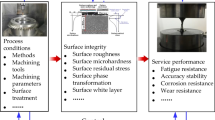Abstract
Recently, surface texturing has become a major method for improving the performance of contact bodies. Under tribological conditions, this method increases fatigue strength significantly. Advances in precision machining technology have allowed the production of detailed textures on surfaces. The relationship between surface texturing and tribological performance has been studied extensively in the case of hydrodynamic lubrication with various surface parameters. However, there has been limited study of this relationship under dry contact condition considering various surface parameters, which is the main subject of this study. This study investigated the effect of varying parameters such as the width and depth of surface dimples on the friction coefficient and the maximum shear stress, which are critical factors for fretting fatigue performance. It was found that the dimple width has a greater effect on the friction coefficient than the dimple depth. Furthermore, it was found that the dimple depth has a more significant effect on the maximum shear stress than the dimple width.
Similar content being viewed by others
References
Ralph, I. S., Ali, F., Robert, R. S., and Henry, O. F., “Metal Fatigue in Engineering,” Wiley, pp. 356–364, 2000.
Szolwinski, M. P. and Farris, T. N., “Mechanics of Fretting Fatigue Crack Formation,” Wear, Vol. 198, No. 1, pp. 93–107, 1996.
Hurricks, P., “The Mechanism of Fretting-A Review,” Wear, Vol. 15, No. 6, pp. 389–409, 1970.
Lindley, T., “Fretting Fatigue in Engineering Alloys,” International Journal of Fatigue, Vol. 19, No. 93, pp. 39–49, 1997.
Nishioka, K. and Hirakawa, K., “Fundamental Investigations of Fretting Fatigue: Part 3, Some Phenomena and Mechanisms of Surface Cracks,” Bulletin of JSME, Vol. 12, No. 51, pp. 397–407, 1969.
Hutson, A. L., Nicholas, T., Olson, S., and Ashbaugh, N., “Effect of Sample Thickness on Local Contact Behavior in a Flat-on-Flat Fretting Fatigue Apparatus,” International Journal of Fatigue, Vol. 23, Suppl. 1, pp. 445–453, 2001.
Ding, J., Houghton, D., Williams, E. J., and Leen, S. B., “Simple Parameters to Predict Effect of Surface Damage on Fretting Fatigue,” International Journal of Fatigue, Vol. 33, No. 3, pp. 332–342, 2011.
Chakherlou, T. N., Mirzajanzadeh, M., and Vogwell, J., “Effect of Hole Lubrication on the Fretting Fatigue Life of Double Shear Lap Joints: An Experimental and Numerical Study,” Engineering Failure Analysis, Vol. 16, No. 7, pp. 2388–2399, 2009.
Buch, A., “Fatigue and Fretting of Pin-Lug Joints with and without Interference Fit,” Wear, Vol. 43, No. 1, pp. 9–16, 1977.
Hattori, T., Kawai, S., Okamoto, N., and Sonobe, T., “Torsional Fatigue Strength of a Shrink Fitted Shaft,” Bulletin of JSME, Vol. 24, No. 197, pp. 1893–1900, 1981.
Ripoll, M. R., Podgornik, B., and Vižintin, J., “Finite Element Analysis of Textured Surfaces under Reciprocating Sliding,” Wear, Vol. 271, No. 5, pp. 952–959, 2011.
Santner, E., Klaffke, D., Meine, K., Polaczyk, C., and Spaltmann, D., “Demonstration of Topography Modification by Friction Processes and Vice Versa,” Tribology International, Vol. 39, No. 5, pp. 450–455, 2006.
Etsion, I., “State of the Art in Laser Surface Texturing,” Journal of Tribology, Vol. 127, No. 1, pp. 248–253, 2005.
Podgornik, B., Vilhena, L., Sedlaèek, M., Rek, Z., and Žun, I., “Effectiveness and Design of Surface Texturing for Different Lubrication Regimes,” Meccanica, Vol. 47, No. 7, pp. 1613–1622, 2012.
Author information
Authors and Affiliations
Corresponding author
Rights and permissions
About this article
Cite this article
Choi, Y., Lee, J. A study on the effects of surface dimple geometry on fretting fatigue performance. Int. J. Precis. Eng. Manuf. 16, 707–713 (2015). https://doi.org/10.1007/s12541-015-0094-1
Received:
Revised:
Accepted:
Published:
Issue Date:
DOI: https://doi.org/10.1007/s12541-015-0094-1




